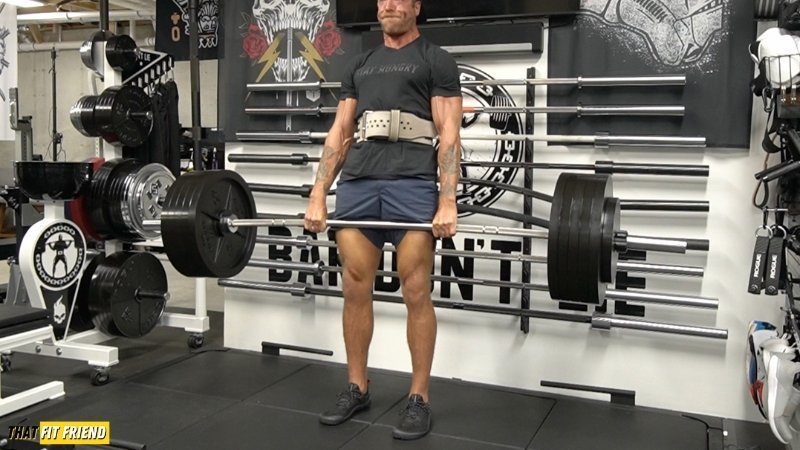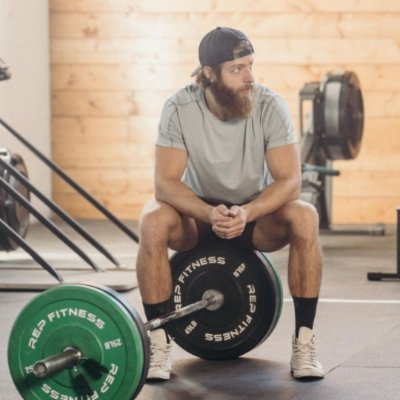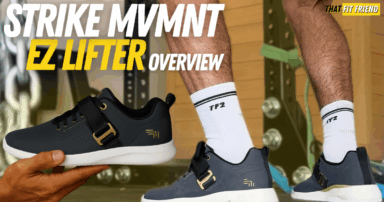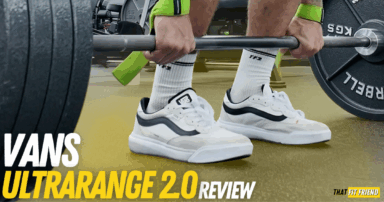In the world of strength training, there are multiple types of weightlifting belts that you can use to support and benefit your performance. If you’re new to weightlifting belts then you might be wondering which lifting belt is best for you.
The three most common types of lifting belts that you’ll see in the gym include velcro belts, lever belts, and prong belts. All three of these weightlifting belts have their time and place depending on your style of training.
Table of Contents+
Weightlifting Belt Takeaways
What Is a Velcro Lifting Belt?
A velcro lifting belt is what I would call a “right of passage” weightlifting belt. This is usually the first belt lifters put on when they’re starting to explore supportive strength gear.
Velcro belts are typically good beginner-friendly lifting belts because they have lower price points and short break-in periods compared to their leather prong and lever peers.
Every velcro lifting belt will have a few common construction features. Below are three features that you can expect to get if you invest in a Velcro lifting belt.
- Metal Buckle: Most velcro belts utilize a metal buckle for durability and support purposes. If you use or buy a velcro belt with a plastic buckle, throw it in the trash.
- Thick Velcro Strap: Every velcro belt will obviously have a long velcro strap which is great for giving you a lot of variability regarding how tight and loose you can wear your belt.
- Mesh and Nylon Materials: The brunt of a velcro belt will usually be made with nylon and mesh materials that have a little rigidity to them. This is useful for promoting rigidity while still being flexible.
Keep in mind, that every velcro belt will be built slightly differently. In my opinion, it’s always a good idea to opt for brands that have been around for a while or choose belts with multiple positive reviews. Don’t skimp out on supportive gear.
When to Use a Velcro Belt
- You’re a beginner and want to experiment with lifting belts and what it’s like to use one for strength training.
- You do CrossFit or plan to only wear your belt for cross-training settings where your workouts will be variable.
- You’re doing strongman or other activities that require a lot more torso flexion.
- You don’t want a super rigid belt but still plan to train heavily and want a little support.
- You’re a weightlifter and want a belt with more pliability for the snatch and clean & jerk.
When to Not Use a Velcro Belt
- Powerlifting and for settings where you want the maximum amount of stability possible. In these cases, a velcro belt might not provide enough for your specific training needs.
- You’re a recreational lifter and want a heavier belt for primarily compound movements like squats and deadlifts and you have no desire to cross-train or do CrossFit with your belt investment.
What Is a Lever Weightlifting Belt?
A lever weightlifting belt is one of the most popular options for powerlifters and lifters who are getting more serious with their strength training. These belts are designed to be heavier and more rigid in nature.
Lever belts get their name because of the lever system they utilize to create consistent tightness. The lever on a lever belt is designed to promote seamless and consistent tightness for every one of your sessions.
While there’s some nuance that exists between different lever belts depending on the company there are a few common construction features that you can expect with this belt.
- Lever System: Every lever belt will utilize a lever for promoting stability and tightness. Some levers are designed to have a single fit once adjusted while others such as the SBD Lever Belt have adjustability.
- Typically 10mm or 13mm Leather: Lever belts will also typically come with a thickness of 10mm and 13mm. Generally, 10mm will be the best option for most lifters as it has good rigidity, but it’s not overly stiff.
- Heavy Stitching: Most lever belts have a nice durable stitching pattern throughout to promote leather and mesh durability. Typically, you’ll see belts use a single-stitch pattern around the outskirts of its material.
With lever belts, I would highly suggest keeping an eye on a company’s warranty with this type of belt. This belt should last you years and buying one with a good warranty is always a safe bet.
When to Use a Lever Belt
- You compete or plan to compete in powerlifting. Lever belts are a popular option for powerlifters at all skill levels.
- You want maximal rigidity for deadlifts and squats. A lever belt’s thickness will be great for promoting torso rigidity.
- You want to “set and forget” your lifting belt. Lever belts are convenient because you don’t have to adjust them every time you use them. A quick click and release is all you need.
When to Not Use a Lever Belt
- For CrossFit workouts or cross-training sessions where you plan to wear your belt for a variety of movements including some dynamic exercises. A lever belt’s stiffness can be limiting in this context.
- For beginners that don’t plan on going super heavy with their training. In this context, a lever belt may be overkill for this lifter and athlete’s needs.
- For lifters that have a high amount of variability in their torso thickness. If you constantly fluctuate with your weight and torso thickness then a lever belt’s consistent fit may actually be more of an inconvenience for your needs.
- For weightlifting. Very rarely will you say weightlifters wear a lever belt for snatches and clean & jerks.
What Is a Prong Weightlifting Belt?
A prong lifting belt is another popular option for general lifters and athletes. After you’ve mastered lifting belts with a Velcro belt, you’ll usually follow with a prong belt because many gyms keep them on hand.
Prong belts are designed to promote a lot of rigidity and have more customization regarding their fit from workout to workout. This is why a lot of gyms will keep this type of belt on hand as they’re great for a wide range of clientele and sizes.
Prong belts are similar to lever belts regarding the materials they use to promote rigidity. The main difference, though, is their buckle and prong system and how they promote stability.
- Prong Buckle System: Most prong belts will utilize a single or double-prong construction. In my opinion, you should always go with a single-prong lifting belt as it’s easier to use and less of a hassle to get on and off.
- Thick Leather Construction: Like lever belts, most prong belts will utilize a thickness that varies. Belts for competition will vary between 10-13mm and more general prong belts for activities like bodybuilding can be <10mm thick.
- Heavy Stitching: Prong belts will also utilize a heavy stitch to keep their leather secure and their mesh overlays if you opt for a prong belt with a softer internal and external material.
Since prong belts can be a little more expensive such as lever belts, I typically suggest lifters use the mindset of “buy once, cry once.” Spend on quality and a good warranty and your prong belt should last you a long time.
When to Use a Prong Belt
- You want a rigid belt for squats, deadlifts, and heavy compound exercises. If your goal is maximal rigidity it’s hard to miss with a good prong belt.
- You want a belt for powerlifting or you plan to compete in powerlifting. Prong belts are great for powerlifting because they’re super rigid but they’ll also give you more sizing variability if you’re cutting for competition and don’t feel like adjusting your lever.
- You want rigidity and sizing variability. As mentioned above, prong belts can be clutch for lifters that have more fluctuations with their torso thickness and size.
- You want a belt that will last a long time. Most prong belts, like lever belts, should last you multiple years if you take good care of them.
- You’re a weightlifter getting heavier with their working sets. For weightlifting athletes, you’ll usually see a thinner prong belt with a tapered construction from the back to the front of their belt (wider back, skinnier front).
When to Not Use a Prong Belt
- For CrossFit and cross-training workouts where you have a high degree of variability. Like lever belts, prong belts may be too rigid in this context and can get uncomfortable.
- For beginners that want a lighter belt with less rigidity and thickness. If you’re new to lifting and you’re much more casual then you may want a velcro belt over a stiffer prong belt.
As you get more specific with your lifting, strength sport, and general training, it’s normal to try out and use different weightlifting belts. This is a normal progression that most lifters will navigate in their career.
Not to mention, we all have fit and feel preferences so you’ll want to explore different of weightlifting belts to see what belt resonates most with you and what materials you prefer when training.
Frequently Asked Questions (FAQ)
Q:What does a lifting belt do?
Q:Do you really need a lifting belt?
Q:How long should you wear a lifting belt?
Q:When should I start wearing a lifting belt?
Takeaway Thoughts
In the gym, velcro, lever, and prong lifting belts all have their time and place. There are some training contexts where a velcro belt makes the most sense whereas there are other contexts where a prong and lever belt make more sense.
When in doubt, remember that a velcro belt will be a lot more versatile with its construction and performance, but it will have less overall rigidity when training.
A lever and prong belt will be the best options for maximal support and rigidity, and a prong belt will give you more variability regarding their sizing.
If you have additional questions about the weightlifting belts featured in this article or which you should go with, drop a comment below or reach out to me via Instagram (@jake_boly or @that_fit_friend).















Add a Comment